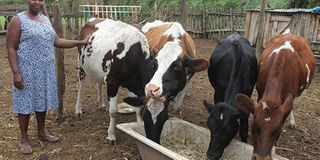Avoiding the unending losses due to mastitis

Gladice Barchok feeds her dairy cows at her Soilo farm in Nakuru. All dairy herds usually have cows with subclinical mastitis but the prevalence of infected animals varies between 5 and 75 per cent while infected quarters range from 2 to 40 per cent. PHOTO | JOHN NJOROGE | NMG
What you need to know:
- Mastitis is the inflammation of the mammary gland caused mostly by bacterial infection. Other causes of the disease include fungi and algal micro-organisms.
- Some infections are so severe leading to dead tissues of the udder, which sloughs off a condition known as gangrenous mastitis. In other cases, the infection is mild and it is referred to as subclinical mastitis.
- All dairy herds have cows with subclinical mastitis but the prevalence of infected animals varies between 5 and 75 per cent while infected quarters range from 2 to 40 per cent.
- The confirmation involves culturing the organisms in the bacterial media while identification uses microscopes and biochemical tests. Identifying the effective drug involves carrying out diagnostic sensitivity test.
About 40 per cent of all confirmed diseases in many veterinary laboratories across the counties are cattle mastitis cases.
This shows not only the threat the disease poses but also that there is an urgent need to set up diagnostic laboratories within the reach of farmers.
To set up such a facility, one needs to understand mastitis, its economic importance, what the laboratory tests involve and the equipment necessary.
Cattle mastitis
Mastitis is the inflammation of the mammary gland caused mostly by bacterial infection. Other causes of the disease include fungi and algal micro-organisms.
Mammals, humans included, therefore, get mastitis. However, since cattle are the major source of the consumed milk in the country, cattle mastitis is given preference here.
Once infected, quantity and quality changes in milk take place. The quantity goes down in most cases and the quality changes from the opaque white liquid to one or more forms of coloured, clotted or watery liquid with or without foul smell.
The udder too changes such that it swells, there is pain, heat and redness. Sometimes the infection spreads to the whole body in which case it is referred to as systemic. In the systemic situation, there is fever, lack of appetite and sometimes shock.
Some infections are so severe leading to dead tissues of the udder, which sloughs off a condition known as gangrenous mastitis. In other cases, the infection is mild and it is referred to as subclinical mastitis.
Economic losses through mastitis
Direct economic importance comes through loss of milk, which is discarded during the recommended three days’ treatment; loss of permanent or temporary production by one or more of the four quarters of the udder that are affected; loss of a variable animal through slaughter or death in non-treatment responsive mastitis and the cost of the curative and preventive medicines plus occasional rejection of milk at the dairies due to subclinical mastitis.
The indirect costs involve treatment of people who develop hypersensitivity to medicine residues used in mastitis treatment, development of antimicrobial resistance against human and animal drugs due to the frequent exposures of the drugs during mastitis treatment and loss of business for milk outlets that depend on an infected herd.
All dairy herds have cows with subclinical mastitis but the prevalence of infected animals varies between 5 and 75 per cent while infected quarters range from 2 to 40 per cent.
This implies that loss of one quarter in 10 per cent of the producing animals would lead to a 2.5 per cent reduction in produced milk.
The implication is that in a county where producers earn Sh6 billion annually, this translates to a loss of Sh150 million annually.
On the antimicrobial resistance, trial and error to treat the various mastitis causing bacteria species such as Staphylococcus, Streptococcus, Pseudomonus, Corrynebactrium, Mycoplama and others, all of which require specific drugs, leads to resistance of the micro-organisms with the danger of a situation when there will be no drug to treat mastistis plus other animal and human diseases caused by these organisms.
Laboratory confirmation and equipment required
With milk, confirmation of mastitis, identification of the causative agent and the drugs that the isolated organism is sensitive to goes hand and in hand.
The confirmation involves culturing the organisms in the bacterial media while identification uses microscopes and biochemical tests. Identifying the effective drug involves carrying out diagnostic sensitivity test.
The whole procedure requires technical knowhow, a facility designed for laboratory services, amenities like water, electricity and waste disposal mechanisms.
It also requires equipment such as microscopes, incubator, fridge, inoculation hood and others in addition to a host of chemical reagents and other materials.
Institutions with the capacity to set up testing laboratories
There are several public veterinary laboratories, which are sparsely distributed across the country namely in Kericho, Nakuru, Eldoret, Karatina, Kabete, Garissa, Mariakani, Ukunda and Witu.
These laboratories test for mastitis in addition to other disease diagnostic services at subsidised fees.
There is opportunity for them to set up satellite laboratories not only in all the counties but also in sub-counties, including in the counties that host them.
Universities and other training and research institutions touching on animal health; medical laboratories; private animal health service providers; dairy cooperative societies; large-scale farms; county and national governments as well as interested investors can also open such facilities and provide the service at a fee.
Before setting up such laboratories, it is important to consult relevant authorities that include and are not limited to the veterinary department; Kenya Veterinary Medicine Directorate; existing laboratories within the region that one intends to setup the facility; National Environmental Management Authority as well as other regulatory authorities.




